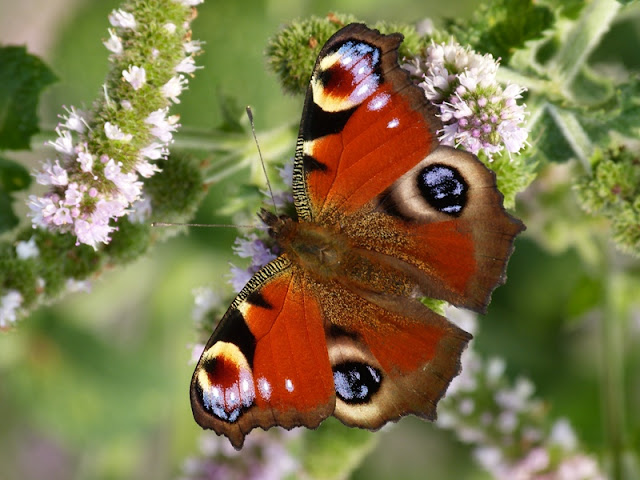The weather in 2016 was very similar to the previous year. I hope this
isn't going to become the norm! The winter of 2015/16 was reasonably mild
again, with only one dusting of snow. We had very heavy rain in February
causing localised flooding, but the rest of the year was reasonably dry. Sadly,
it was also quite cool and cloudy with below average sunshine.
One unusual aspect of the weather in 2016 was the number of easterly winds we had and this
seemed to bring cloud with it.
We had very local torrential rain in June which washed away the
caterpillars I had been nurturing in my garden. I suspect it may have had a
similar impact across much of East Lothian impacting on the butterfly numbers
later in the year.
Despite this I still received almost as many butterfly records this
year as I did last year. The combined efforts of everyone recording butterflies
has built up a very good picture of what is going on in East Lothian.
Red Admiral, Vanessa atalanta
The first butterfly seen in East Lothian in 2016 was a Red Admiral on 3 February and interestingly the last record I received of a butterfly flying was also a Red Admiral on 16 November. In between they were regularly seen with numbers peaking in August. The early sightings over the last few years would indicate that Red Admirals have been able to survive the last few mild winters we have had.
Peacock, Aglais io
The first record in 2016 was on 13 March and Peacocks were
regularly seen until early June. Although the numbers in the summer months were lower than we normally see, they continued to be seen flying
until 4 November.
Small
Tortoiseshell, Aglais urticae
Small Tortoiseshells were seen regularly from 14 March until the middle
of July as expected, but when we would normally expect to see an increase in
numbers in late summer and autumn, numbers were disappointingly low. This
corresponds with the national story and I can only imagine that the cool summer
weather caused a lot of caterpillars to perish. I notice that the records where
more than one Tortoiseshell was recorded were all on the coast. We are finding
a few Small Tortoiseshells hibernating in the usual sites, although fewer than
normal, but hopefully enough to boost the population again this year.
Green-veined
White, Pieris napi
The first record was on 14th April and they were seen through to the 27th
September. The spring brood were as numerous as normal, but they weren’t
seen in anything like the normal numbers during the summer generation. However, when I check the numbers recorded on the transect the summer numbers were better.
Speckled
Wood, Pararge aegeria
Speckled Woods continued to do well in East Lothian in 2016. The first
record I received was on 19 April and they were very regularly recorded with no
apparent break between the three generations until 31 October. The peak numbers
appeared in August, which is different from previous years, when the numbers
were highest in September. The Speckled Wood has spread west and south, meaning
that it is now found in most suitable habitats in East Lothian.
Comma, Polygonia c-album
Commas were first seen on 19 April in three different locations! There were only 19 records for
the whole year, which is considerably down on 2014 and 2015. This is a
butterfly that had been building up in numbers since it first was recorded here
about 15 years ago, but it certainly didn't seem to do well in 2016.
Orange
Tip, Anthocharis cardamines
The first Orange Tip was recorded on 19 April and they were seen in
good numbers through to 26 June. Being an early species, they were
unaffected by the poor summer weather, but let’s hope that there isn’t an
impact on the 2017 population.
Small
White, Pieris rapae
The first Small White was recorded on 19 April. It was interesting that
I received more Small White records in 2016 than in previous years, but with
smaller numbers in each record. There was a fairly clear division between the
first generation – April to mid-June and the second generation from mid-July to
23 September.
Large
White, Pieris brassicae
The first Large Whites were recorded on a transect in early April. They were recorded until 10 September in better numbers than normal. I can't imagine why they did so well in 2016. I remember them laying eggs very late in 2015 and I didn't think the caterpillars stood a chance of surviving the early frosts. It seems they can!
Painted
Lady, Vanessa cardui
2016 was a “Painted Lady year”. These remarkable butterflies arrived
here in early May and were recorded in good numbers right through to 4th
November. Thereafter they hopefully made it back to Africa, from where their
great grandparents would have set out back in March.
Small
Copper, Lycaena phlaeas
The first record of a Small Copper was on 6 May and they were recorded
very regularly until 13 September. Nationally, the Small Copper didn’t do well
last year, but in East Lothian they seemed to buck the trend a bit. The second generation of the year wasn't as numerous as the spring generation. We never see
great numbers of them, but in 2016 I received more records than in previous
years.
Green
Hairstreak, Callophrys rubi
The first Green Hairstreak record was on 19 May and they were seen through to 6 June in three different
areas of woodland north of the Lammermuir Hills. They haven't previously been recorded at two of these sites. Interestingly there were no records from
the more remote and difficult to reach areas of the Lammermuirs, possibly
because no one made the effort to search those areas.
I will continue with the rest of the butterflies seen in East Lothian in 2016 in my next post.

























